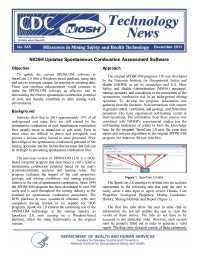Mining Publication: Technology News 545 - NIOSH Updates Spontaneous Combustion Assessment Software
Original creation date: December 2011
To update the current SPONCOM software to SponCom 2.0 with a Windows-based platform, using tabs and easy-to-navigate screens for entering or selecting data. These user interface enhancements would continue to make the SPONCOM software an effective tool in determining the relative spontaneous combustion potential of coal, and thereby contribute to safer mining work environments. Statistics show that in 2011 approximately 15% of all underground coal mine fires are still caused by the spontaneous combustion of coal. Spontaneous combustion fires usually occur in mined-out or gob areas. Fires in these areas are difficult to detect and extinguish, and present a serious safety hazard to mine personnel. Prior knowledge of the spontaneous combustion potential of the mining operation and the factors that increase that risk can be strategic in preventing spontaneous combustion fires. The previous version of SPONCOM (1.0) is a DOS-based computer program that determines a coal’s relative spontaneous combustion potential based on the coal’s proximate/ultimate analyses and heating value. The program evaluates the impact of the coal properties, geologic and mining conditions, and mining practices relative to the risk of spontaneous combustion. Since 1994 the SPONCOM program has been distributed to over 300 users and is used throughout the mining industry as the standard for spontaneous combustion assessment. The DOS platform is now considered obsolete, with new computers having limited or no support for DOS programs. SponCom 2.0 ensures the continuing use of the SPONCOM technology in the mining industry as SponCom 2.0, now running on a Windows-based platform, offers the same functionality as the original version.
Authors: AJ Kwitowski, AM Carilli, AC Smith
Technology News - December 2011
NIOSHTIC2 Number: 20040121
Pittsburgh, PA: U.S. Department of Health and Human Services, Public Health Service, Centers for Disease Control and Prevention, National Institute for Occupational Safety and Health, DHHS (NIOSH) Publication No. 2012-109, TN 545, 2011 Dec; :1-2
See Also
- CFD Modeling of Spontaneous Heating in a Large-Scale Coal Chamber
- The Effect of Ventilation on Spontaneous Heating of Coal
- Proceedings of the International Workshop on Rock Mass Classification in Underground Mining
- Refuge Alternatives in Underground Coal Mines
- Safe and Economical Inerting of Sealed Mine Areas
- SPONCOM - A Computer Program for the Prediction of the Spontaneous Combustion Potential of an Underground Coal Mine
- SponCom - Spontaneous Combustion Assessment Software - 2.0
- Spontaneous Combustion
- Technology News 441 - SPONCOM - An Expert System to Predict Spontaneous Combustion Potential of a Coal Mining Operation
- Wireless Mesh Mine Communication System
- Content source: National Institute for Occupational Safety and Health, Mining Program


 ShareCompartir
ShareCompartir
